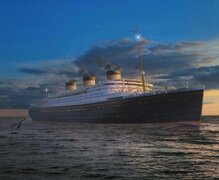I have read with some interest the claims that the Oceanic III was not planned to have been built at 1000+ feet long. Long a student of this ship, I this evening pulled out my source notes and research material and gave it a read through. (I’ve not conducted any active research on this ship for a good decade.)
The inescapable conclusion that I continually arrived at is that the Oceanic III was intended to be or to surpass 1000 feet in length. Every source agrees with this conclusion.
For starters, two respected Harland & Wolff employees are to be consulted. Cuthbert Coulson Pounder, Director and Chief Technical Engineer of H&W after WWII, released details of the Oceanic that must be accepted as fact due to his position and the fact that H&W nor its employees would have had any reason to lie about a ship that was 20 years distant and never built.
Pounder said that the ship “would have had 47 six-cylinder, exhaust turbo-charged, four-stroke single-acting diesel engines producing a total of 275,000 i.h.p. and coupled in pairs to electric generators. The total weight of the installation would have been some 17,000 tons, equal to the displacement tonnage of a smaller liner of the day!” Additionally the ship “was to measure 60,000 gross tons with an overall length of 1,010 feet, a beam of 120 feet and a draught of 38 feet.” (Damned by Destiny, David Williams and Richard P. De Kerbrech, 1982)
Dr. Denis Rebbeck, a director at Harland & Wolff, delivered a paper read before Section G of the British Association on Friday, September 5, 1952. This paper gave great detail the history of the shipyard, and contained additional facts about the Oceanic III that cannot be ignored. He wrote that “The Musgrave Shipyard will also be long remembered by the people of Belfast as the yard where the keel of a 1000-ft. Diesel-electric passenger liner was laid down for the White Star Line in the late 1920’s …” and “the total power of the ship was designed to be 200,000 shaft horse-power on four screws, and there were to be 47 six-cylinder super-charged four-stroke Diesel engines, coupled in pairs.”
This same paper shows the profile and engine arrangement of the Oceanic III in a plan which must be accepted as Gospel. Indeed, this outline profile is still used today as the basis for all renditions of the ship, as well it should be. It was produced during the design phase for the ship, and was reproduced in print a mere 24 years after the laying of the keel. I hold in great suspicion any plans purporting to show the ship at a shorter length than 1000 feet.

